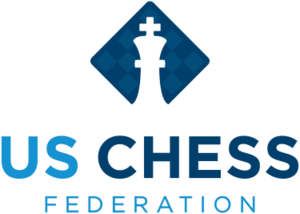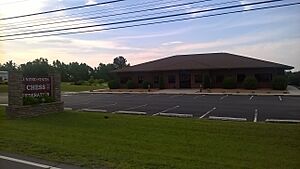United States Chess Federation facts for kids
 |
|
| Abbreviation | US Chess or USCF |
|---|---|
| Formation | December 27, 1939 |
| Merger of | American Chess Federation (ACF), National Chess Federation (NCF) |
| Headquarters | 333 S 18th St. Suite 210 St. Louis, Missouri |
|
Region served
|
United States |
|
Membership (2022)
|
93,000+ |
|
President
|
Randy Bauer (Iowa) |
|
Vice President
|
Kevin Pryor (Florida) |
|
Executive Director
|
Carol Meyer |
| Affiliations | FIDE |
|
Staff
|
30 |
The United States Chess Federation (also called US Chess or USCF) is the main group for chess in the United States. It helps organize chess games and represents the U.S. in FIDE, which is the World Chess Federation.
US Chess manages the official national rating system. It also gives out national titles and holds more than twenty national championships each year. They publish two magazines: Chess Life and Chess Life for Kids. The USCF started in Illinois in 1939. It was formed when two older chess groups joined together. It is a non-profit group and its main office is in St. Louis, Missouri. In 2024, it had about 112,000 members.
Contents
How US Chess Started
In 1939, the United States Chess Federation was created in Illinois. This happened when the American Chess Federation and the National Chess Federation joined forces.
The American Chess Federation used to be called the Western Chess Association. It had held a big yearly championship since 1900. After the groups merged, this tournament became the U.S. Open. The National Chess Federation started in 1927. Its goal was to help the U.S. play in the Olympiads. This group had also held the important U.S. Championship since 1936.

When US Chess first started, it had about 1,000 members. Membership slowly grew until 1958. That year, Bobby Fischer won the U.S. Championship when he was just 14 years old. This started the "Fischer era." During this time, USCF membership grew a lot, reaching about 60,000 by 1974. This was after Fischer won the World Chess Championship.
The "Fischer era" didn't last forever. But US Chess has continued to grow a lot since then. A big reason for this growth is the huge increase in scholastic chess. This means chess played in schools. Now, there are national championship tournaments for different grades and ages. These tournaments attract thousands of players. None of these big school tournaments existed before 1969.
At first, US Chess had no employees or a main office. But in 1952, they hired a Business Manager. This job eventually became the Executive Director. The first office was in New York. Over the years, the main office moved several times. It went from Newburgh, New York (1967) to New Windsor, New York (1976). Then it moved to Crossville, Tennessee (2006). Finally, in 2022, it moved to St. Louis, Missouri.
How US Chess is Run
The U.S. Chess Federation has two main groups that help run it. The Board of Delegates has about 140 people. These people are chosen by chess groups in each state. They meet once a year at the U.S. Open.
The Executive Board has eight people. Members of US Chess vote for these people. They serve for four years. This board meets every month.
Player Ratings
| Category | Rating Range |
|---|---|
| Senior Master | 2400 and up |
| National Master | 2200–2399 |
| Expert | 2000–2199 |
| Class A | 1800–1999 |
| Class B | 1600–1799 |
| Class C | 1400–1599 |
| Class D | 1200–1399 |
| Class E | 1000–1199 |
| Class F | 800–999 |
| Class G | 600–799 |
| Class H | 400–599 |
| Class I | 200–399 |
| Class J | 100–199 |
US Chess uses rating systems for chess players. A rating is a number that shows how strong a player is. This number is figured out based on how a player does in tournaments against other rated players. Tournament organizers send game results to US Chess. Then, US Chess calculates the ratings and shares them online.
A player can have different ratings for different types of games. These include games played by mail, games played in person (slow, quick, or blitz), and online games (slow, quick, or blitz). You can find ratings online on the US Chess Player Search page. Ratings for games played in person usually range from 100 to almost 3000. A higher rating means a stronger player. Tournament organizers often use ratings to decide who can play in certain sections or win "class" prizes.
USCF first started a rating system for in-person games in 1950. It used a formula made by Kenneth Harkness. In 1960, USCF began using a better system. This system was invented by Arpad Elo, a physics professor and chess master. Elo worked with USCF for many years. The system he created, or a similar one, was later used by FIDE. It is also used in other games and sports. USCF has made changes to the rating calculation over the years. The current way of calculating ratings was influenced by the "Glicko rating system." This system was developed by Professor Mark Glickman and improved on Elo's system.
Chess Titles
| Title | Rating Level |
|---|---|
| Life Senior Master | 2400 |
| Life Master | 2200 |
| Candidate Master | 2000 |
| 1st Category | 1800 |
| 2nd Category | 1600 |
| 3rd Category | 1400 |
| 4th Category | 1200 |
US Chess gives out special titles to players for their achievements over time. These titles are different from the titles awarded by FIDE. FIDE titles include Grandmaster and International Master.
If a player reaches a rating of 2200 or higher, US Chess gives them the title of National Master. They also get a certificate. A Senior Master certificate is given for a rating of 2400 or higher. Before 2008, the only other title was Life Master. This was given to players who played 300 or more rated games and kept a rating above 2200.
In 2008, USCF started a system of "norms-based titles." This system is similar to how FIDE awards titles. For example, if a player shows a strength above 2400 in five tournaments, and their rating eventually reaches 2400, they can earn the Life Senior Master title. The old Life Master title was renamed Original Life Master. This was done to avoid confusion with the new Life Master title. Both titles are recognized by US Chess. Titles are shown on the same Player Search web page as ratings.
National Championships
US Chess organizes or approves many national championships. Most of these tournaments happen every year.
The oldest championship is the U.S. Open. It started in 1900 as the Western Open in Minnesota. The U.S. Open is like the big annual meeting for US Chess. The yearly meeting of the Delegates happens at the same time. Many smaller meetings and events also take place. Several hundred players join this tournament. The most players ever was 836 in 1983 in Pasadena.
Five special invitation-only events are held at the same time. Each state chess group chooses a player to represent them in each of these five events. These events are:
- The National Tournament of Senior State Champions (for players aged 50 and up)
- The GM Arnold Denker National Tournament of High School State Champions (grades 9-12)
- The Dewain Barber National Tournament of Middle School State Champions (grades 6-8)
- The John D. Rockefeller National Tournament of Elementary School State Champions (grades K-5)
- The Ruth Haring National Tournament of Girls State Champions (grades K-12)
Players usually get into these events by winning a state championship. However, each state group can choose its players using other rules.
The U.S. Championship is an invitation-only event. It has been held since 1936. Before that, the national champion was often decided by head-to-head matches. Famous past winners include Samuel Reshevsky and Bobby Fischer, who each won eight times. Walter Browne won six times. Larry Evans, Gata Kamsky, and Hikaru Nakamura each won five times. In 2023, Fabiano Caruana won the tournament.
The U.S. Women's Championship is also by invitation. It has been held since 1937. In recent years, it has been held at the same time as the U.S. Championship. In 2023, Carissa Yip won this tournament.
The biggest national championships for kids are the Elementary (grades K-6), Junior High (grades K-9), and High School (grades K-12) Championships. These are held every spring. Every four years, a "Supernationals" event combines all three of these tournaments into one. The last Supernationals in 2017 brought over 5,500 players to Nashville, Tennessee. It was said to be the largest rated chess tournament ever. The oldest of these three, the National High School, first took place in 1969.
The Elementary, Junior High, and High School championships are different from the National Grade Level Championships. These are held in December. In these tournaments, each grade level from kindergarten to 12th grade has its own championship.
Most of the tournaments listed above are organized by US Chess itself. But the US Chess calendar also includes many events that other groups can bid to host. Here is a partial list of other national events:
| National Open | open to all |
| U.S. Junior | by invitation; for players under age 21 |
| U.S. Junior Open | open to all; for players under age 21 |
| U.S. Cadet | by invitation; for players under age 16 |
| U.S. Senior Open | open to all; for players age 50 or over |
| Pan-American Intercollegiate | open to all; for teams from colleges |
| U.S. Masters | open to all; for players with a rating of 2200 or over |
| U.S. Class Championships | open to all |
| U.S. Amateur (North, South, East, West) | for players with a rating under 2200 |
| U.S. Amateur Team (North, South, East, West) | open to all; for teams |
| All-Girls National | open to all girls |
US Chess also organizes national championships for correspondence chess. This is chess played by mail or email.
| Absolute Correspondence Chess Championship | by invitation |
| Golden Knights | open to all; played by mail or e-mail |
| Electronic Knights | open to all; played by e-mail only |
See also
- Executive Directors of the United States Chess Federation
- Fédération Internationale des Échecs (FIDE)
- International Correspondence Chess Federation (ICCF)
- Presidents of the United States Chess Federation
- Scholastic chess in the United States

